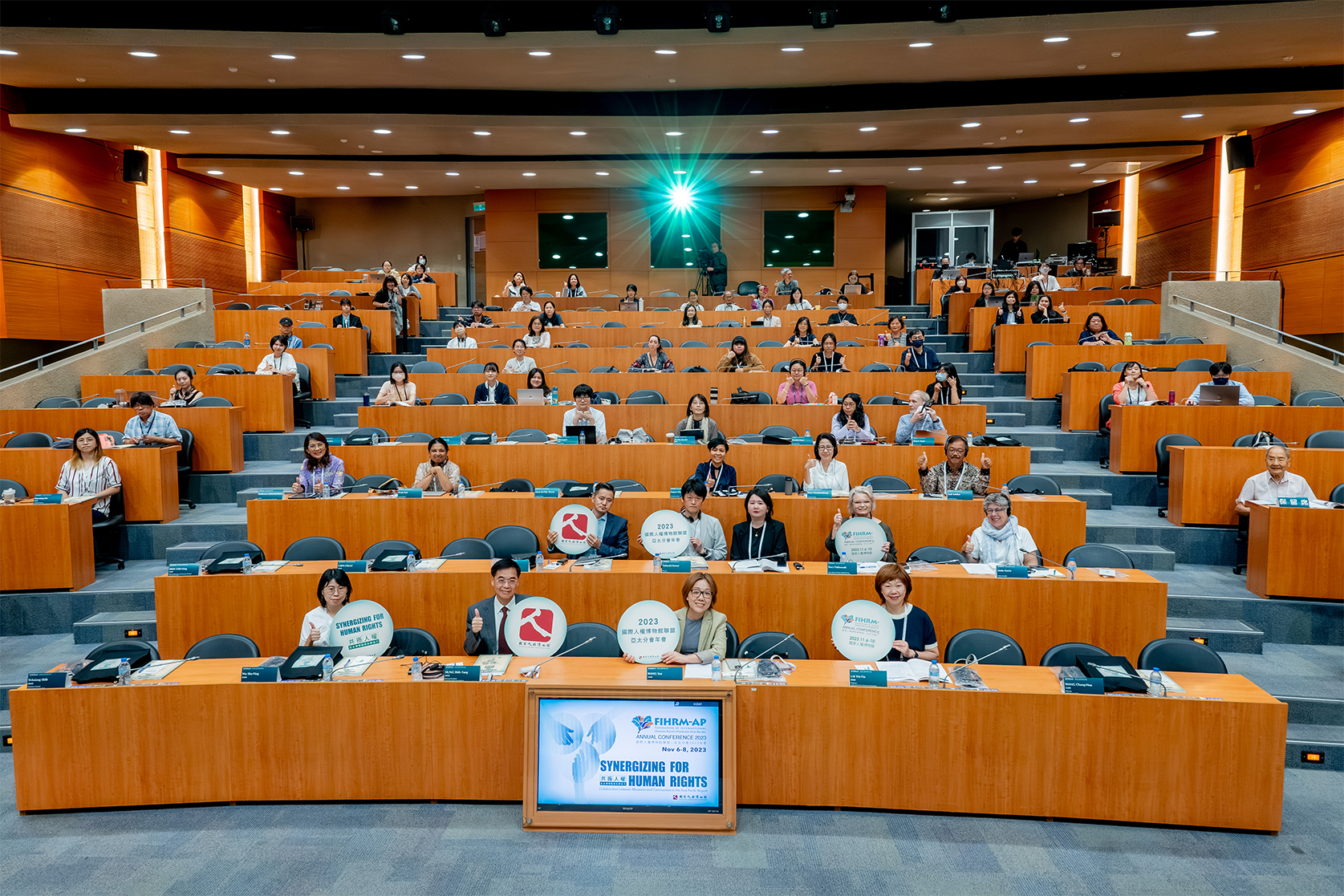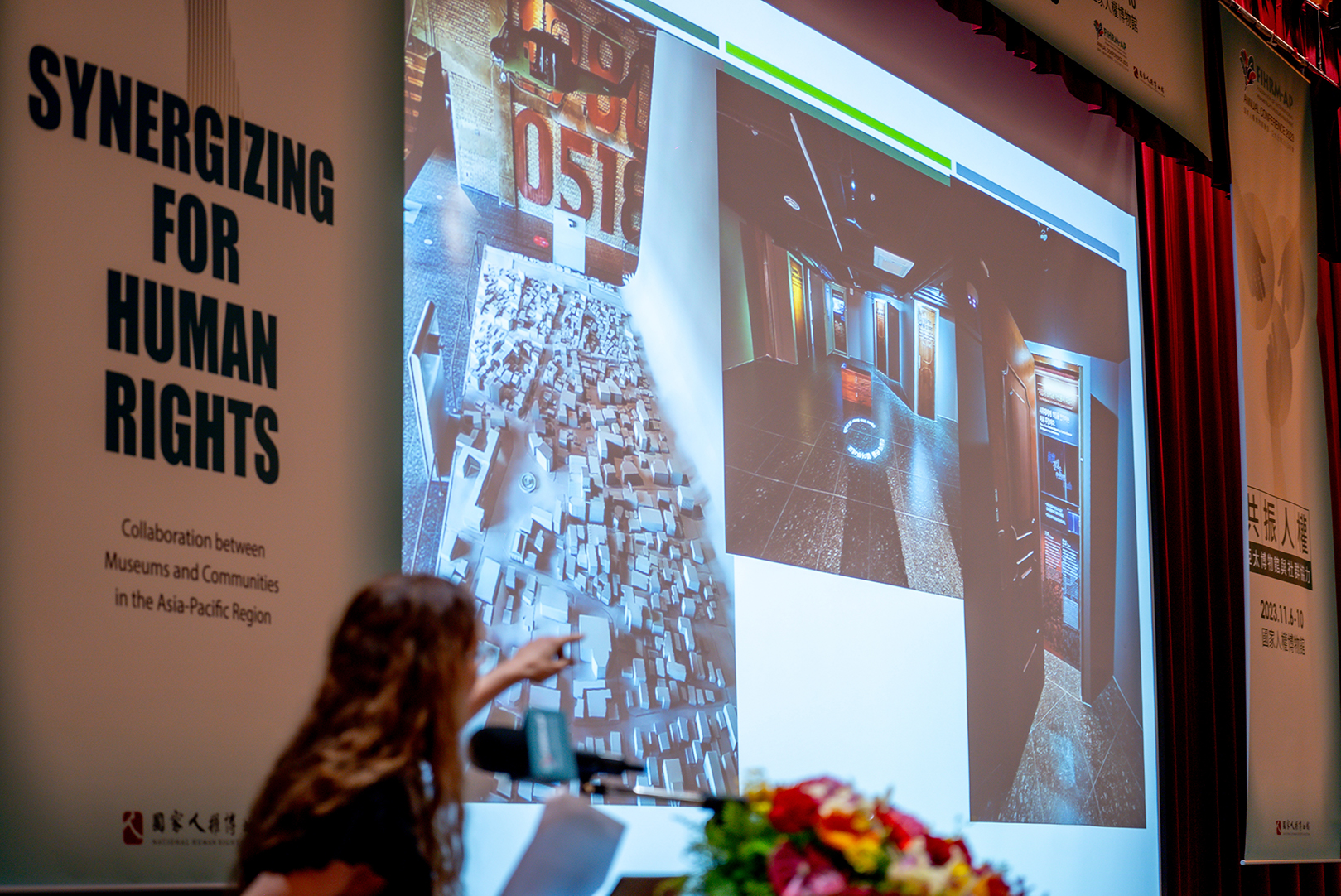THE SIXTH ISSUE OF FIHRM-AP - The Power of Action: FIHRM-AP 2023 on Synergizing for Human Rights (I)
Co-authors: Chen Yi-Shan and Ngan Yuet, students at the Graduate Institute of Museum Studies, Fu Jen Catholic University (FJU)
The Power of Action: FIHRM-AP 2023 on Synergizing for Human Rights (I)

The opening ceremony for the 2023 FIHRM-AP Annual Conference "Synergizing for Human Rights: Collaboration Between Museums and Communities in the Asia-Pacific Region" (© FIHRM-AP)
Introduction
The Federation of International Human Rights Museums - Asia Pacific (FIHRM-AP) aims to establish itself as a platform that connects international and Asia Pacific museums with human rights-related organizations. Through dialogue and collaboration, FIHRM-AP seeks to promote the practice and realization of contemporary human rights ideals.
The FIHRM-AP annual conference was held in Taiwan for the first time in 2023. Organized by the National Human Rights Museum (NHRM), the event spanned three days starting from November 6 under the theme "Synergizing for Human Rights." Among the participants were museum professionals, researchers, and human rights workers hailing from Taiwan, Japan, Indonesia, Nepal, India, Thailand, Vietnam, Australia, and other regions. The conference featured three keynote speeches, a presentation of 16 research papers, and a workshop by the International Coalition of Sites of Conscience (ICSC). Through these various formats, the conference brought new insights and inspiration to the promotion of human rights education, negative heritage, community collaboration, and migration and interdisciplinary human rights issues to generate a synergizing effect among museums and across various fields.
In addition to experts, scholars, and attendees concerned about human rights issues from around the world, political victims of the White Terror era such as Chen Chin-Sheng, Chang Tse-Chou, Chou Hsien-Nung, and Wu Kuo-Shou were also present and personally expressed their heartfelt gratitude and encouragement to the attending human rights workers.

Richard Benjamin, Senior Lecturer in Contemporary Museum Practice and Co-Director of the Centre for the Study of International Slavery in University of Liverpool, UK shared the progress made in Liverpool towards addressing local issues related to slave trade. (© FIHRM-AP)
The Power of Museums—Just Do It!
When working with difficult history, museums can do much more besides reflection and commemoration! As Richard Benjamin, Senior Lecturer in Contemporary Museum Practice and Co-Director of the Centre for the Study of International Slavery in University of Liverpool, UK, aptly stated, "We remember; we act." Benjamin discussed how the International Slavery Museum (ISM) in Liverpool incorporates personal stories and family histories that easily resonate with viewers when handling the history of the slave trade. This approach has promoted public awareness and understanding of sensitive history.
By collaborating and co-creating with local groups, the ISM has become an advocate for contemporary human rights issues. Exhibitions and other forms of documentation have been utilized to record human rights violations during the colonial period in the Congo[1] and recent movements such as Black Lives Matter. This method has also been used to explore past, present, and future human rights issues from different perspectives and through various approaches.
Contemporary museums have shifted their focus towards a more diverse range of communities in their efforts to promote inclusivity. In recent years, the Suiheisha History Museum in Japan, founded with the mission of "anti-discrimination against indigenous peoples," has turned its attention to the accessibility rights of individuals with diverse identities, undertaking a redesign and implementing innovative exhibition narratives and display techniques. This includes the installation of interactive touch panels and the adjustment of display heights to accommodate children and wheelchair users.
In terms of content, the museum has incorporated a wide variety of audience-friendly media including puzzle cards, picture books, and comics into exhibitions. By enhancing audience engagement with interesting and easily readable materials, the museum aims to lower the barriers to exhibition attendance. In doing so, it seeks to present human rights principles to visitors of diverse backgrounds and age groups.
The future is the present. Technology continues to bring us closer to the future. The rapid development of Artificial Intelligence (AI) is one of the most prominent topics in recent years. Tracy Puklowski, Senior Director of the Northern Territory Government in Australia, presented the potential and the risks of integrating AI into museums. For instance, AI data analysis can help museums identify the characteristics and needs of their audience, thereby creating a more personalized museum experience. It can also be utilized to ensure a comfortable and inclusive exhibition experience for neurodiverse individuals[2].
AI can even assist museums in handling sensitive issues, interpreting difficult histories in multiple languages, and even creating immersive digital replicas for virtual repatriation. This approach views the repatriation of cultural artifacts as an opportunity to facilitate cultural dialogue and relationship building between both parties, rather than a loss or relinquishment. For museum staff, the trend of AI calls for learning how to ensure information veracity and allowing recent technologies to play a positive role in museums.
A more interactive museum experience can also be provided through diverse forms of media such as art, illustrated story books, and games. Professor Lin Bao-An of the General Education Center at the National Penghu University of Science and Technology, along with his team, collaborated with the Human Rights Team of the Penghu County Compulsory Education Counseling Group to transform the facts surrounding the 713 Incident in Penghu into a board game called "Exile Files."
Through the board game as a medium that young players are familiar with, they can examine the life stories of the Shandong exiles who suffered through war, forced conscription, wrongful accusations and imprisonment due to the 713 Incident in Penghu, and even death by firing squad. The game also highlights the struggles of the exiled students and teachers to resume their education, establish roots in an unfamiliar environment, and their eventual exoneration.
Conference attendees played the board game "Exile Files" outside the venue. (© FIHRM-AP)
Conference attendees played the board game "Exile Files" outside the venue. (© FIHRM-AP)
In the case of Taiwan, National Human Rights Museum Director Hung Shih-Fang discussed the dilemmas the museum has encountered while positioning itself and promoting social dialogue within the historical context of authoritarian rule. These include whether it should primarily function as a “difficult heritage” or as a “museum,” whether it should adopt a more “political” or a more “diverse” human rights approach, and whether it should prioritize “heritage preservation” or “revitalization.” Hung also mentioned the difficulties in executing decisions in light of how "archives may not always convey the truth” and “interviews may not qualify as records," as well as the strategies implemented to attract a broader audience.
A New Position on Negative Heritage—the Representation and Transformation of Traumatic Memories
The difficulties and anxiety surrounding negative heritage
As a tangible space or intangible memory that encompasses various forms of trauma, negative heritage is also referred to as "difficult heritage." According to Associate Professor Huang Shu-Mei of the Institute of Building and Planning, National Taiwan University, the challenges associated with difficult heritage can be divided into two aspects: Firstly, at the superficial level, historical darkness and heaviness becomes tied to the specific physical environments and heritage structures which can trigger a sense of discomfort among people. Secondly, at an internal level, the differences in the perspectives and experiential understanding of various communities with vested interests result in contradicting narratives and mutual rejection. In such complex historical contexts, holding a singular narrative often oversimplifies the actual circumstances surrounding the perpetrators/victims and the colonizers/colonized. Only by establishing long-term mutual trust and collaboration within the community can true reconciliation and consensus be achieved.
Ph.D. Candidate Chu Fang-Yi of the Institute of Cultural Anthropology and Development Sociology, Leiden University, Netherlands also discussed how negative heritage can trigger anxiety among local residents. Taking the Green Island Human Rights Memorial Monument as an example, the memorial monument is a painful visual reminder for the islanders since the majority of political prisoners were held in Green Island Prison in the past. Moreover, the monument is regarded by the largely Han Chinese residents as a medium for interacting with spirits, gods, and ancestors. The "inauspiciousness" associated with the memorial monument has caused islanders to take aggressive acts such as "spilling dog blood” in an attempt to remove its “impurities” and perceived dangers. This highlights the clash arising from the grey area between Han ethnic traditional beliefs of ghost and deity worship and the subjectivity of the monument. It also provides an opportunity to rethink and reflect upon the concept of monumental landscapes.
The musealization of negative heritage breaks the dominance of a single historical narrative and creates space for collective memory
Monuments established to remember a conflict should be set up with the view of commemorating victims, memorializing traumatic memories, and avoiding the repetition of mistakes. However, the single historical narrative posited by authoritarian governments often benefits those in power, interpreting oppressed minority groups as rebels, and lacking diverse perspectives.
Lecturer Padtheera Narkurairattana from the Institute of Human Rights and Peace Studies, Mahidol University, Thailand presented on the Dusun Nyor Monument in the deep south of Thailand and the Seven Martyrs Blessed Memorial of Song Khon in northeastern Thailand, highlighting the prolonged dominance of Buddhism in Thailand and the resulting suppression and human rights violations against minority groups practicing other religions, such as Malay Muslims and Catholics. By gathering collective memories from different ethnic groups, Narkurairattana explored how to reclaim the intended functions of these monuments. This involves restoring dignity to the communities that have suffered, emphasizing the importance of monuments as spaces for collective memory, and preventing future incidents of religious persecution.

Associate Professor María del Pilar Álvarez explained the process of transforming historical sites into museums, using the May 18 Gwangju Democratization Movement as a case study. (© FIHRM-AP)
Museums are not only places for collections, exhibitions, and education, but also have the function of preservation and representation. By transforming negative heritage into museums, historical events can be actively remembered. Associate Professor María del Pilar Álvarez of the Korean Studies Program, School of Social Sciences, El Salvador University, Argentina conducted a qualitative case study on the memory sites of Gwangju, South Korea. Through methods such as interviewing members of The May 18 Foundation, Álvarez analyzed the process of musealization of over ten memory spaces related to the May 18 Democratization Movement in Gwangju. She established that the representation and territorialization of memories are constructed through collective memory and spatial frameworks. Gwangju has become a "city of memory" because it has preserved the sites of memories and has received strong support from the local community.
With state violence as the core of its presentation, Assistant Professor Andi Achdian from Sociology Program Study in Universitas Nasional (UNAS), Jakarta, Indonesia as well as Board Member of Munir Human Rights Museum has taken the Comarca-Balide Museum as a case study to explore the practical basis of transforming unjust sites, such as the prison that housed political prisoners in East Timor in 1975, into human rights museums, giving new meaning to these spaces. At the same time, actively integrating universal human rights and incorporating LGBTQ, women's rights, and children's rights issues into exhibitions will not only generate responses to contemporary issues, but also encourage audience members to reflect and take actions.
[1] In 2015, the International Slavery Museum in Liverpool, UK, collaborated with the Congo Reform Association to organize the exhibition "Brutal Exposure: The Congo." This exhibition documented the exploitation and brutality experienced by the people of the Congo under the forced colonization by King Leopold II of Belgium.
[2] "Neurodiversity" refers to the diversity of human neurological development. This concept includes various groups related to neurological development, such as individuals with ADHD, autism spectrum disorders, developmental language disorders, developmental motor disorders, and learning disabilities.


